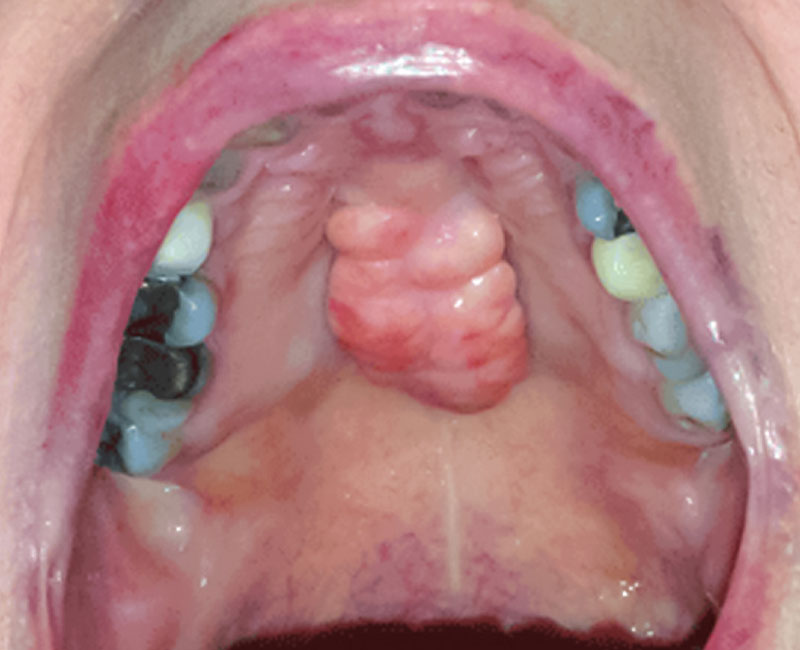Torus palatinus refers to a bony growth on the roof of your mouth. These growths are harmless, but can be uncomfortable and inconvenient. You can be born with torus palatinus or develop it later in life. Removal isn’t necessary unless the growth causes complications or interferes with speech or swallowing.
Advertisement
Cleveland Clinic is a non-profit academic medical center. Advertising on our site helps support our mission. We do not endorse non-Cleveland Clinic products or services. Policy

Torus palatinus refers to a bony growth on your hard palate (the roof of your mouth). These growths, which vary in size and number, are harmless and generally don’t cause pain. Torus palatinus usually doesn’t require treatment unless it interferes with speech, swallowing or other functions. You might be born with the condition, or you might develop it later in life.
Advertisement
Cleveland Clinic is a non-profit academic medical center. Advertising on our site helps support our mission. We do not endorse non-Cleveland Clinic products or services. Policy
You can get torus (singular) or tori (plural) under your tongue, too — on the floor of your mouth. Healthcare providers call these bony growths mandibular tori (torus mandibularis) because they form on your mandibular (lower) jaw.
Between 20% and 30% of the general population has palatal tori. The condition is more common in females. It’s also more prevalent among certain ethnic groups, including East Asians, Europeans and West Africans.
A torus palatinus almost always forms in the center of your hard palate (the roof of your mouth). You might be born with it, or it might develop gradually over time.
Torus palatinus symptoms may include:
Additionally, many people with palatal tori feel self-conscious about their condition. If you have anxiety about living with torus palatinus, tell your healthcare provider. They can discuss appropriate treatment options with you.
Experts don’t really know what causes palatal tori or why some people are more likely to get them. However, they’ve identified some potential risk factors, which we’ll explore below.
Advertisement
Possible risk factors for torus palatinus include:
Palatal tori aren’t harmful or dangerous. They don’t mean you have an infection or cancer. But when palatal tori grow very large, or if they develop near other oral structures, they may cause complications, such as:
Palatal tori are usually obvious unless they’re very small. In most cases, a dentist makes the diagnosis during a routine exam.
Testing may not be necessary to diagnose torus palatinus. However, your dentist may take a CT (computed tomography) scan to rule out any other issues.
Healthcare providers don’t usually recommend treatment unless oral tori interfere with function or your quality of life. When necessary, oral surgery is the go-to torus palatinus treatment.
Oral surgeons usually perform torus palatinus removal. During this procedure, a surgeon will:
Though uncommon, complications are possible. They include:
It can take up to one month to fully heal after torus palatinus surgery. To foster a speedy and comfortable recovery:
Advertisement
If you have torus palatinus and it’s not interfering with your quality of life, you don’t need to do anything. You should, however, make sure you mention it to your dentist or healthcare provider so they can confirm the diagnosis and rule out other conditions.
No. Once you develop torus palatinus, it won’t go away without surgery.
It’s uncommon, but possible. Most people only need one surgery to remove the bony growth.
There’s nothing you can do to prevent palatal tori. If you have torus palatinus, let your healthcare provider know if you notice any major changes. Addressing issues early can reduce your risk of further complications.
Any time you see a new or unusual growth in your mouth, you should let your healthcare provider know. They can confirm the diagnosis and rule out other conditions.
If you’ve been living with torus palatinus, call your provider if:
No, oral tori aren’t dangerous or cancerous. But if you develop bony growths or bumps on the roof of your mouth, you should tell your dentist or healthcare provider. They can confirm the diagnosis and rule out other conditions.
Advertisement
A torus palatinus is a harmless, noncancerous, bony growth on the roof of your mouth. You’re probably used to it if you were born with it. But it may feel alarming or worrisome if you develop it later in life. Palatal tori aren’t a cause for concern, and you don’t need to do anything about them unless they interfere with your quality of life. If they start to hinder the way you speak, chew or swallow, it’s time to tell your dentist. They can refer you to an oral surgeon for appropriate treatment.
Advertisement
If you have conditions affecting your ears, nose and throat, you want experts you can trust. Cleveland Clinic’s otolaryngology specialists can help.

Last reviewed on 03/19/2023.
Learn more about the Health Library and our editorial process.